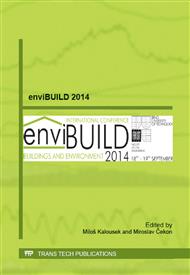p.83
p.87
p.92
p.96
p.105
p.109
p.113
p.117
p.121
Possible Solutions for Ground Slabs of Energy Efficient Buildings
Abstract:
The building envelope is a barrier that separates the internal environment from the effects of weather. This barrier ought to facilitate the optimal comfort of the interior environment in winter as well as summer. It has been shown in practice that most building defects occur within the building envelope. This includes external walls, roofs and floors too, and is impartial to new or renovated buildings. Heat losses of buildings through external constructions – roof, external walls, ground slabs are not negligible. It is therefore important to pay more attention to these construction elements. Basementless buildings situated on the ground are in direct contact with the subgrade and its thermal state. An amount of heat primarily destined for the creation of thermal comfort in the interior escapes from the baseplate to the cooler subgrade. The outgoing heat represents heat losses, which unfavourably affect the overall energy efficiency of the building. The heat losses represent approximately 15 to 20 % of the overall heat losses of the building. This number is a clear antecedent for the need to isolate and minimalize heat flow from the building to the subgrade.
Info:
Periodical:
Pages:
105-108
Citation:
Online since:
October 2014
Authors:
Price:
Сopyright:
© 2014 Trans Tech Publications Ltd. All Rights Reserved
Share:
Citation:


